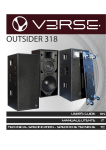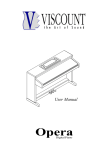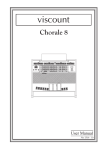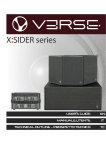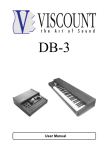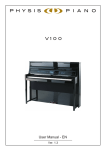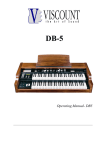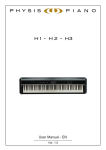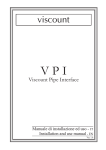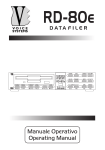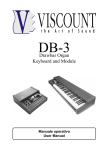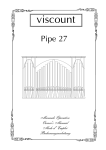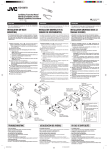Download 1. note importanti - Viscount International
Transcript
viscount Annunciator Panel Manuale d'Uso - IT User Manual - EN Ver. 1.0 viscount Annunciator Panel Manuale Utente INDICE 1. Note importanti .................................................................................. 2 1.1 Cura del prodotto ......................................................................................... 2 1.2 Note riguardanti il manuale ......................................................................... 2 2. Introduzione ....................................................................................... 4 3. Comandi e connessioni ...................................................................... 5 4. Normale funzionamento .................................................................... 7 5. Impostare la modalita’ di trasmissione ............................................. 8 6. Aggiornamento del firmware ............................................................. 9 1 viscount Annunciator Panel Manuale Utente 1. NOTE IMPORTANTI 1.1 CURA DEL PRODOTTO Non applicate eccessiva forza alle strutture ed ai comandi del dispositivo (interruttori, connettori, ecc…). Non collocare, quando possibile, il dispositivo in prossimità di unità che producano forti interferenze come apparecchi radio – TV, monitor, ecc... Evitate di posizionare il dispositivo in prossimità di fonti di calore, in luoghi umidi o polverosi o nelle vicinanze di forti campi magnetici. Evitate di esporre il dispositivo all’irradiazione solare diretta. Non introdurre per nessuna ragione oggetti estranei o liquidi di qualsiasi genere all’interno il dispositivo. Per la pulizia usate solo un pennello morbido od aria compressa, non usate mai detergenti, solventi od alcool. Collegate il cavo di alimentazione ad una presa di corrente provvista di contatto di terra. Accertatevi che la tensione di rete corrisponda a quella indicata sulla targhetta matricola dell’apparato. In caso di lunghi periodi di inutilizzo scollegate la spina della presa di corrente. 1.2 NOTE RIGUARDANTI IL MANUALE Conservate con cura questo manuale. Il presente manuale costituisce parte integrante il dispositivo. Le descrizioni e le illustrazioni contenute nella presente pubblicazione si intendono non impegnative. Ferme restando le caratteristiche essenziali dello strumento, il costruttore si riserva il diritto di apportare eventuali modifiche di parti, dettagli ed accessori che riterrà opportune per il miglioramento del prodotto o per esigenze di carattere costruttivo o commerciale, in qualunque momento 2 viscount Annunciator Panel Manuale Utente e senza impegnarsi ad aggiornare tempestivamente questa pubblicazione. Tutti i diritti sono riservati, è vietata la riproduzione di qualsiasi parte di questo manuale, in qualsiasi forma, senza l’esplicito permesso scritto del costruttore. Tutti i marchi citati all’interno del manuale sono di proprietà delle rispettive case produttrici. Leggete attentamente tutte le informazioni descritte. Eviterete inutili perdite di tempo ed otterrete le migliori prestazioni dal dispositivo. Le sigle od i numeri riportati tra parentesi quadre ([ ]) stanno ad indicare i nomi di interruttori, led e connettori presenti nel dispositivo. Per esempio la scritta [RADIO SIGNAL] indica il led RADIO SIGNAL. Le illustrazioni e le videate del display sono puramente a scopo informativo e possono differire da quelle che vengono realmente visualizzate. 3 viscount Annunciator Panel Manuale Utente 2. INTRODUZIONE COSA E’ L’Annunciator Panel: L’Annunciator Panel è un display a 3 cifre, utilizzabile con gli organi della serie Unico e/o con il lettore di brani musicali Choir Master, atto alla visualizzazione di numeri che indicano quale brano verrà eseguito. COME VENGONO VISUALIZZATI I NUMERI: Il numero viene fornito dal nome del brano caricato, più precisamente dai primi 3 caratteri del nome del file seguiti dal carattere “underscore” (per es. 001_Kyrie,eleison.mid). Tenete pertanto presente che con file i cui nomi che non iniziano con questa sintassi non è possibile visualizzare il numero sull’Annunciator Panel. Tramite il Choir Master è inoltre possibile visualizzare un numero a piacere tenendo premuto il pulsante [A.PANEL] e componendo la cifra utilizzando i pulsanti numerici della sezione SONG STRUCTURE. COME SI COLLEGA L’Annunciator Panel: L’Annunciator Panel può ricevere le informazioni via radio o via cavo. Il collegamento via radio non necessita di alcuna connessione, ma in caso di utilizzo con gli organi Unico occorre installare all’interno dell’organo l’apposito ricevitore fornito con il radiocomando Remote Radio Controller (a tal fine consultare il manuale d’uso del radiocomando). Il collegamento via cavo è fattibile utilizzando la connessione MIDI oppure tramite cavo con connettore RJ-45 diretto EIA/TIA-568B (se la distanza dell’Annunciator Panel è superiore ai 15 metri i cavi RJ-45 sono di più facile reperibilità rispetto a quelli MIDI). I collegamenti possibili sono i seguenti: - se il brano viene riprodotto da un organo Unico: da [MIDI OUT] dell’organo a [MIDI IN] dell’Annunciator Panel utilizzando un cavo MIDI. - se il brano viene riprodotto dal Choir Master : da [A.PANEL] del Choir Master a [CHOIR MASTER] dell’Annunciator Panel utilizzando un cavo RJ-45. - se il brano viene riprodotto dal Choir Master ma non si ha a disposizione un cavo con connettore RJ-45: da [MIDI THRU] dell’organo Unico o dello strumento con il quale si stanno suonando i brani letti dal Choir Master a [MIDI IN] dell’Annunciator Panel utilizzando un cavo MIDI. 4 viscount Annunciator Panel Manuale Utente 3. COMANDI E CONNESSIONI 1. Led [RADIO SIGNAL]: indica che l’Annunciator Panel sta ricevendo un segnale radio. 2. Led [DATA RECEIVED]: indica che il segnale radio è stato ricevuto ed interpretato. La presenza di questi due led è utile per capire se l’Annunciator Panel sta ricevendo il segnale radio trasmesso dal Choir Master o dall’organo Unico e se questo viene interpretato. 5 viscount Annunciator Panel Manuale Utente Se entrambi i led non si accendono ciò sta a significare che l’Annunciator Panel non sta ricevendo alcun segnale radio. In caso di utilizzo con un organo Unico verificare la corretta installazione del ricevitore radio al suo interno. In caso di utilizzo con il Choir Master verificare che sia selezionata la modalità di trasmissione radio nella pagina a display A.PANEL LINK MODE del menu SETUP. Se tutto ciò risulta corretto contattare l’assistenza tecnica all’indirizzo e-mail [email protected] in quanto ci potrebbero essere problemi agli apparati radio. Se è il solo led rosso ad accendersi ad impulsi regolari ciò sta a significare che l’Annunciator Panel sta ricevendo un segnale radio ma non riesce ad interpretarlo, molto probabilmente a causa del canale radio errato. Verificare che il canale impostato tramite i micro-switch [SETTINGS] (vedi punto 9) e visualizzato dopo aver acceso l’Annunciator Panel sia lo stesso di quello impostato: o nel Choir Master : nella pagina a display A.PANEL LINK MODE del menu SETUP o nell’organo Unico: nella pagina a display REMOTE CONTROL del menu UTIL. & MIDI. Accedere alla pagina tenendo premuto il pistoncino [S]. Se è il solo led rosso ad accendersi frequentemente, se non a rimanere continuamente acceso, ciò sta a significare che l’Annunciator Panel si trovare in un’area con forti segnali e/o disturbi radio. In questo caso provare ad installarlo in un altra posizione e/o ruotare l’antenna. 3. Connettore [MIDI IN]: connettore DIN a 5 poli per la ricezione dei dati MIDI. I collegamenti effettuabili sono descritti nel cap. 2. 4. Connettore [CHOIR MASTER]: connettore RJ-45 per la ricezione dei dati da utilizzarsi con cavo diretto EIA/TIA-568B. I collegamenti effettuabili sono descritti nel cap. 2. 5. Connettore [AC INPUT]: inserire qui il cavo di alimentazione fornito con il dispositivo. 6. Interruttore [POWER ON]: interruttore di accensione e spegnimento. 7. Connettore [:]: inserire ed avvitare qui l’antenna fornita in dotazione con il dispositivo. 8. Staffa per il fissaggio a muro con fori da 8 mm. 6 viscount Annunciator Panel Manuale Utente 9. Micro-switch [SETTINGS]: micro-switch per la selezione della modalità di trasmissione dei dati, il canale radio ed il numero identificativo del dispositivo. Per maggiori informazioni consultare il cap. 5. N.B.: - Il nome di ogni comando e connessione è serigrafato nel lato posteriore dell’Annunciator Panel. - Sebbene si utilizzino comuni cavi Ethernet, la connessione via cavo RJ-45 non è di tipo Ethernet, ma è di tipo seriale RS-485. Quindi non è possibile collegare l’Annunciator Panel a dispositivi Ethernet. 4. NORMALE FUNZIONAMENTO Subito dopo l’accensione il display visualizza la release del firmware attualmente installato indicata con la lettera “r”. Se è selezionata la modalità di trasmissione radio vengono inoltre forniti il canale ed il numero identificativo del dispositivo impostati con i micro-switch [SETTINGS] (vedi cap. 5), indicati rispettivamente da una lettera “c” ed una “d”. Questa una sequenza di esempio delle videate di accensione: dopo le quali il dispositivo è pronto per ricevere le informazioni sul numero del brano caricato. Se viene caricato un brano il cui nome non inizia con tre numeri (vedi anche cap. 2) il display visualizza tre trattini: Se non viene ricevuto alcun segnale radio entro 5 secondi (se, per esempio, l’organo Unico o il Choir Master sono stati spenti), il dispositivo viene automaticamente spento. 7 viscount Annunciator Panel Manuale Utente 5. IMPOSTARE LA MODALITA’ DI TRASMISSIONE Come descritto nel cap. 2, l’Annunciator Panel può ricevere le informazioni sul numero del brano caricato via radio, via cavo MIDI o via cavo RJ-45. La modalità al momento selezionata viene indicata, all’accensione, con gli acronimi: La modalità di trasmissione è selezionabile ponendo i seguenti micro-switch [SETTINGS] (vedi punto 9 del cap. 3) in posizione ON: - solo micro-switch 4: trasmissione tramite cavo MIDI; - solo micro-switch 5: trasmissione tramite cavo RJ-45 (Serial); - micro-switch 4 e 5: trasmissione via radio. Selezionando la modalità radio, è necessario impostare il canale di trasmissione che deve essere lo stesso di quello selezionato: o nel Choir Master : nella pagina a display A.PANEL LINK MODE del menu SETUP o nell’organo Unico: nella pagina a display REMOTE CONTROL del menu UTIL. & MIDI. Accedere alla pagina tenendo premuto il pistoncino [S]. Nell’Annunciator Panel il canale si seleziona tramite i micro-switch 1, 2 e 3. Fate riferimento alla seguente tabella per la regolazione del canale: Micro-switch 1 ON OFF ON OFF Micro-switch 2 ON ON OFF OFF Micro-switch 3 ON ON ON ON 8 Canale 0 1 2 3 viscount Annunciator Panel Micro-switch 1 ON OFF ON OFF Manuale Utente Micro-switch 2 ON ON OFF OFF Micro-switch 3 OFF OFF OFF OFF Canale 4 5 6 7 Sempre in modalità radio, qualora siano presenti più Annunciator Panel , per essere sicuri che tutti i dispositivi ricevano correttamente le informazioni sul numero del brano caricato, è necessario assegnare ad ognuno un diverso numero identificativo del dispositivo. Questo si assegna tramite i microswitch 6, 7 e 8. Fate riferimento alla seguente tabella per l’assegnazione del numero identificativo di dispositivo: Micro-switch 6 ON OFF ON OFF ON OFF ON OFF Micro-switch 7 ON ON OFF OFF ON ON OFF OFF Micro-switch 8 ON ON ON ON OFF OFF OFF OFF N.° dispositivo 0 1 2 3 4 5 6 7 6. AGGIORNAMENTO DEL FIRMWARE Qualora si reputi necessario aggiornare il firmware dell’Annunciator Panel , Viscount fornirà un file nominato vvv_pnlupl.mid, dove vvv sta ad indicare la versione del nuovo firmware. Per caricarlo è dapprima necessario collegare il connettore [MIDI IN] dell’Annunciator Panel al MIDI OUT del dispositivo che riproduce il file .mid, che può anche essere lo stesso Choir Master o organo Unico del quale si visualizzano i numeri dei brani. Fatto ciò, è sufficiente riprodurre il file in questione (nel caso di organo Unico tramite il sequencer interno), alla ricezione dei dati il display dell’Annunciator Panel visualizza le diciture “btU” (Boot Upload) e ”UPL” (Upload) con i tre punti che si accendono alternativamente. Al termine della procedura viene visualizzata la dicitura “End” dopodichè il dispositivo effettua una autoriaccensione. 9 Smaltimento dei rifiuti elettrici ed elettronici (applicabile nell’Unione Europea e negli altri paesi europei con servizio di raccolta differenziata) Ai sensi dell’art. 13 del Decreto legislativo 25 luglio 2005, n. 151 “Attuazione delle Direttive 2002/95/CE, 2002/96/CE e 2003/108/CE” II simbolo presente sul prodotto o sulla sua confezione indica che il prodotto non verrà trattato come rifiuto domestico. Sarà invece consegnato al centro di raccolta autorizzato per il riciclo dei rifi uti elettrici ed elettronici. Assicurandovi che il prodotto venga smaltito in modo adeguato, eviterete un potenziale impatto negativo sull’ambiente e la salute umana, che potrebbe essere causato da una gestione non conforme dello smaltimento del prodotto. Il riciclaggio dei materiali contribuirà alla conservazione delle risorse naturali. Per ricevere ulteriori informazioni più dettagliate Vi invitiamo a contattare l’uffi cio preposto nella Vostra città, il servizio per lo smaltimento dei rifi uti o il negozio in cui avete acquistato il prodotto. Lo smaltimento del prodotto da parte dell’utente comporta l’applicazione delle sanzioni amministrative previste dalla normativa di legge. Questo prodotto è conforme ai requisiti delle direttive EMCD 2004/108/EC e LVD 2006/95/EC. User Manual Annunciator Panel INDEX 1. Important notes ................................................................................ 14 1.1 Looking after the product ......................................................................... 14 1.2 Notes about the manual............................................................................. 14 2. Introduction ..................................................................................... 16 3. Comandi e connessioni .................................................................... 17 4. Normal functioning ......................................................................... 19 5. Setting the transmission mode ........................................................ 20 6. Firmware update .............................................................................. 21 13 User Manual viscount Annunciator Panel 1. IMPORTANT NOTES 1.1 LOOKING AFTER THE PRODUCT Do not apply excessive force to the device’s structures or the controls (switches, connectors etc.). When possible, do not place the device close to units which generate strong interference, such as radios, TVs, computer videos, etc. Do not place the device close to heat sources, in damp or dusty places or in the vicinity of strong magnetic fields. Do not expose the device to direct sunlight. Never insert foreign bodies inside the device or pour liquids of any kind into it. For cleaning, use only a soft brush or compressed air; never use detergents, solvents or alcohol. Connect the net cable to an earthed socket. Check that the voltage corresponds to the voltage shown on the serial number plate of the device. If the product is to be out of use for lengthy periods, disconnect the plug from the power socket. 1.2 NOTES ABOUT THE MANUAL Take good care of this manual. This manual is an integral part of the instrument. The descriptions and illustrations in this publication are not binding. While the device’s essential characteristics remain the same, the manufacturer reserves the right to make any modifications to parts, details or accessories considered appropriate to improve the product or for requirements of a constructional or commercial nature, at any time and without undertaking to update this publication immediately. 14 User Manual Annunciator Panel All rights reserved; the reproduction of any part of this manual, in any form, without the manufacturer’s specific written permission is forbidden. All the trademarks referred to in this manual are the property of the respective manufacturers. Read all the information carefully in order to obtain the best performances from your product and waste no time.. The codes or numbers in square brackets ([]) indicate the names of the buttons, sliders, trimmers and connectors on the device. For example, [RADIO SIGNAL] refers to the RADIO SIGNAL led. The illustrations and display pages are purely guideline and may differ from those actually shown on the display. 15 User Manual viscount Annunciator Panel 2. INTRODUCTION WHAT IS THE Annunciator Panel: The Annunciator Panel is a three-digit display, compatible with Unico organs and the music player Choir Master Its purpose is to show a number indicating the song to be performed next. NUMBER VISUALISATION The number appearing on screen derives from the name of the loaded song: the first three digits of the name, followed by the "underscore" symbol. (e.g. 001_Kyrie,eleison.mid). Keep in mind that the Annunciator Panel can only work if the name of the loaded song follows this syntax. The Annunciator Panel can also show any other digit sequence. To assign a sequence manually, press the [A.PANEL] button on your Choir Master and in the meanwhile enter the digits using the SONG STRUCTURE buttons. CONNECTING THE Annunciator Panel: The Annunciator Panel can be connected via radio waves or cable. The radio connection is wireless. In order to use the radio connection with Unico organs, it is necessary to install in the organ itself a receiver, provided with a Remote Radio Controller (see the remote control user manual). To connect the Annunciator Panel via cable, use either a MIDI connection or an RJ-45 cable, direct EIA/TIA-568B. For distances of 15 metres or more, RJ-45 cable are a better option since they are easier to find than MIDI cable of the same length. Possible connections are: - If the song is played on an Unico organ: from [MIDI OUT] of the organ to [MIDI IN] of the Annunciator Panel, through a MIDI cable. - If the song is played by the Choir Master : from [A.PANEL] on the Choir Master to [CHOIR MASTER] on the Annunciator Panel, through a RJ45 cable. - If the song is played on the Choir Master but there is not RJ-45 cable available: from [MIDI THRU] on the Unico organ (or other instrument through which the Choir Master is playing) to the [MIDI IN] of the Annunciator Panel, through MIDI cable. 16 User Manual Annunciator Panel 3. CONNECTIONS AND CONTROLS 1. [RADIO SIGNAL] led: indicates that the Annunciator Panel is receiving a radio signal. 2. [DATA RECEIVED] led: indicates that the radio signal has been received and understood. These two leds help understand if the Annunciator Panel is receiving signal from the Choir Master or from the Unico organ, and whether the signal has been successfully understood. 17 User Manual viscount Annunciator Panel If neither led is on, it means that the Annunciator Panel is not receiving any signal. When connecting the Annunciator Panel to a Unico organ, check that the receiver within the organ has been installed correctly. When connecting with Choir Master, check that the radio transmission mode has been selected in the A.PANEL LINK MODE page under the SETUP menu. If the problem persists, it might be due to malfunctioning radio devices. Should this happen, please contact the technical support at the email address [email protected]. If the red led only blinks at regular interval, it means that the Annunciator Panel receives the signal but is not able to understand it. In this case a radio channel error is likely. Should this happen, check that the radio channel set through the [SETTINGS] micro-switch (see chap. 9) and visualized after switching on the Annunciator Panel corresponds to the channel set: o on the Choir Master , on the A.PANEL LINK MODE page under the SETUP menu. o on the Unico organ, on the REMOTE CONTROL video page under the UTIL. & MIDI menu. To access this page press and hold the [S] piston. If the red led only blinks frequently but does not remain on, this means that the Annunciator Panel is surrounded by heavy radio disturbance. Try installing the device in a different location and/or rotating the antenna. 3. [MIDI IN] connector: 5 pins DIN connector, receives MIDI data. Available connections are described in chap. 2. 4. [CHOIR MASTER] connector: RJ-45 connector. Use with direct cable EIA/TUA-568B. Available connections are describe in chap. 2. 5. [AC INPUT] connector: insert here the power cable (included). 6. [POWER ON] switch: on/off switch. 7. [ : ] connector: insert and screw in here the antenna provided with the device. 8. Wall hanging support with 8mm holes. 9. [SETTINGS] micro-switches: select data transmission mode, radio channel and the identification number of the device. For further information, see chap. 5. 18 User Manual Annunciator Panel N.B.: - Names for each control and connection are printed on the back of the Annunciator Panel. - Although performed through Ethernet cable, the RJ-45 connection is not an Ethernet connection, but a serial RS-485 type. Therefore, the Annunciator Panel cannot be connected to any Ethernet device. 4. NORMAL FUNCTIONING As soon as the display is switched on, it shows the firmware release currently installed, indicated by an "r". If using the radio transmission mode, the device also shows the radio channel and identity number of the device, set through the [SETTINGS] micro switches (see chap. 5), "c" stands for channel and "d" for identity number. This is an example of the video pages: then the device is ready to receive the song codes. When loading a song whose filename does not begin with three digits (see also chap. 2) the display shows three dashes: If the device does not detect any radio signal within 5 seconds (if, for example, the Unico organ or the Choir Master are switched off) it will automatically shut down. 19 User Manual viscount Annunciator Panel 5. SETTING THE TRANSMISSION MODE As described in chap. 2, The Annunciator Panel can be connected via radio waves, MIDI cable or RJ-45 cable. The currently selected transmission mode is shown when the display is switched on. Acronyms are: The transmission mode can be selected by pulling the following [SETTINGS] micro switches in ON position (see point 9 chap. 3): - only micro-switch 4: MIDI cable transmission; - only micro-switch 5: RJ-45 (serial) cable transmission; - micro-switches 4 and 5: radio transmission. Selecting radio mode, it is necessary to set also the radio channel, that must correspond to the one set: o on the Choir Master, on the A.PANEL LINK MODE page under the SETUP menu. o on the Unico organ, in the REMOTE CONTROL video page under the UTIL. & MIDI menu. To access this page press and hold the [S] piston. Select the radio channel of the Annunciator Panel through its micro-switches 1, 2 and 3. To adjust the channel, use the following chart: Micro-switch 1 ON OFF ON OFF ON OFF Micro-switch 2 ON ON OFF OFF ON ON Micro-switch 3 ON ON ON ON OFF OFF 20 Channel 0 1 2 3 4 5 viscount Annunciator Panel Micro-switch 1 ON OFF User Manual Micro-switch 2 OFF OFF Micro-switch 3 OFF OFF Channel 6 7 While in radio mode, if using more than one Annunciator Panel, each device should be assigned a different identity number. To do so, use the microswitches 6, 7 and 8. To assign an identity number, use the following chart: Micro-switch 6 ON OFF ON OFF ON OFF ON OFF Micro-switch 7 ON ON OFF OFF ON ON OFF OFF Micro-switch 8 ON ON ON ON OFF OFF OFF OFF Device n.° 0 1 2 3 4 5 6 7 6. FIRMWARE UPDATE When necessary, Viscount will release firmware updates. The update will be delivered in a file named vvv_pnlupl.mid, where vvv stands for the number of the new firmware release. To load this file, first connect the [MIDI IN] connector of the Annunciator Panel to the MIDI OUT port of the MIDI player you are using, be it the Choir Master or a Unico organ. Now play the file (if you are using a Unico organ, do so via the internal sequencer). While receiving data, the Annunciator Panel shows the acronyms "btU" (Boot Upload) and "UPL" (Upload), with three progressing dots. At the end of the process, the word "End" appears on screen. Then, the device reboots. 21 Disposal of old Electrical & Electronic Equipment (Applìcable throughout the European Union and other European countries with separate collection programs) Dir. 2002/95/CE, 2002/96/CE e 2003/108/CE This syrnbol, found on your product or on its packaging, indicates that this product should not be treated as household waste when you wish to dispose of it. Instead, it should be handed overt to an applicable collection point for the recycling of electrical and electronic equipment. By ensuring this product is disposed of correctly, you will help prevent potential negative consequences to the environment and human health, which could otherwise be caused by inappropriate disposal of this product. The recycling of materials will help to conserve natural resources. For more detailed information about the recycling of this product, please contact your local city offi ce, waste disposal service or the retail store where you purchased this product. This product complies with the requirements of EMCD 2004/108/EC and LVD 2006/95/EC. FCC RULES NOTE: This equipment has been tested and found to comply with the limits for a Class B digital Device, persuant to Part 15 if the FCC Rules. These limits are designed to provide reasonable protection against harmful interference in a residential installation. This equipment generates, uses and can radiate radio frequency energy and, if not installed and used in accordance with the instruction, may cause harmful interference to radio comunications. However, there is no guarantee that the interference will not occur in a particular installation. If this equipment does cause harmful interference to radio or television reception, which can be determinated by turning the equipment off and on, the user is encuraged to try to correct the interference by one or more of the following measures: - Reorient or relocate the receiving antenna. Increase the separation between the equipment and receiver. Connect the equipment into an outlet on a circuit different from that to which the receiver is connected. Consult the dealer or an experienced Radio/Tv technician for help. The user is cautioned that any changes or modification not expressly approved by the party responsable for compliance could void the user’s authority opearate the equipment. INFORMATIONS FCC NOTE : Cet instrument a été controlé et il est garanti pour etre en conformité avec les spécifications techniques établies pour les dispositifs numériques de la « Classe B » selon les normes de protection contre les interférences avec d’autres dispositifs électroniques environnants. Cet appareil produit et utilise des fréquences radio. S’il n’est pas installé et utilisé selon les instructions contenues dans le mode d’emploi, il peut générer des interférences. L’observation des normes FCC ne garanti pas qu’il y aura aucune interférence. Si cet appareil est la cause d’ interférences avec une réception Radio ou TV, il est possible de le vérifier en éteignant puis en allumant l’instrument : Vous pouvez alors résoudre le problème en suivant les procédures suivantes : - déplacer ou orienter l’antenne de l’appareil avec lequel se manifeste l’interférence. déplacer cet instrument ou l’appareil avec lequel se produit l’interférence connecter cet instrument à une prise de courant différente afin de mettre les deux appareils sur deux circuits différents. consulter le revendeur ou un technicien radio/tv pour d’autres renseignements. D’éventuelles modifications non approuvées par le constructeur peuvent annuler votre garantie de l’appareil. viscount Viscount International S.p.A. Via Belvedere Fogliense 154 – 47836 Mondaino (RN), ITALY Tel: +39-0541-981700 Fax: +39-0541-981052 Website: www.viscount.it Distribuito in Italia da TITAN MUSIC S.A. Strada Genghe di Atto, 80 47892 Acquaviva - Repubblica di San Marino Tel. 0549-999164 fax 0549-999490


























